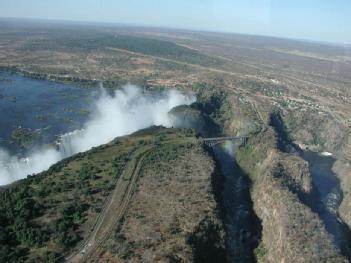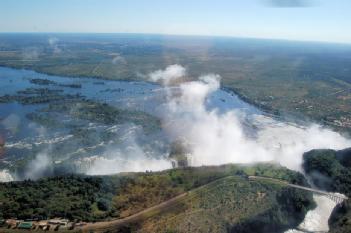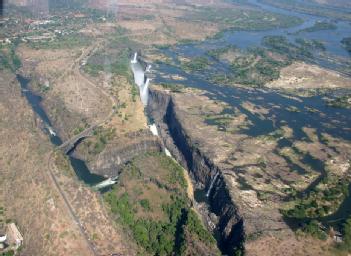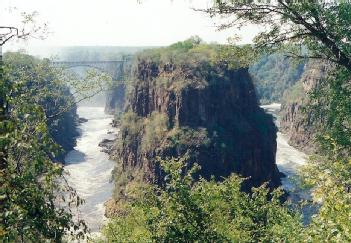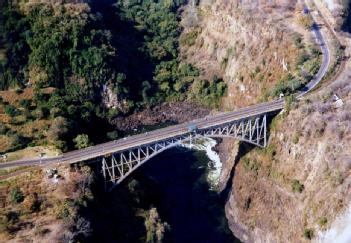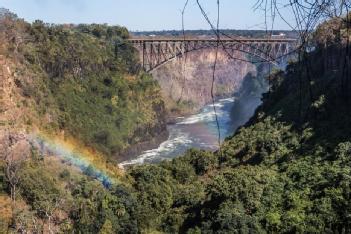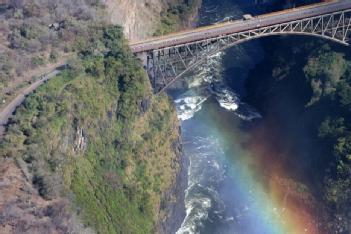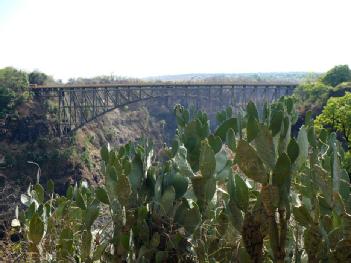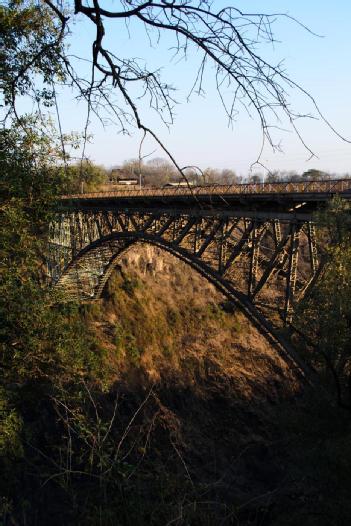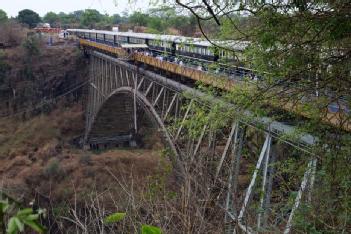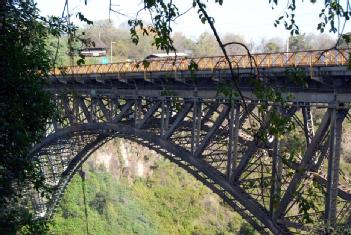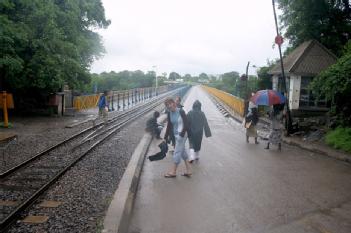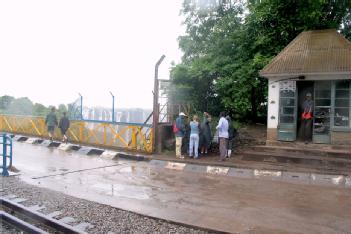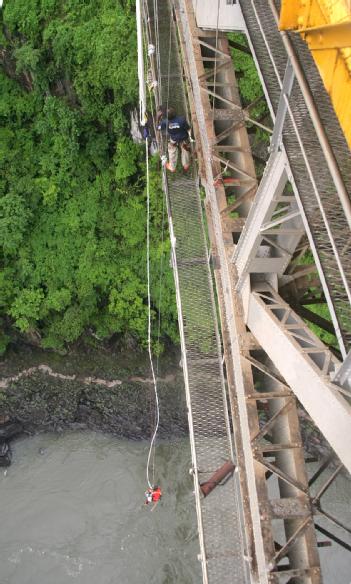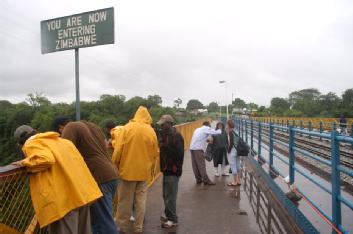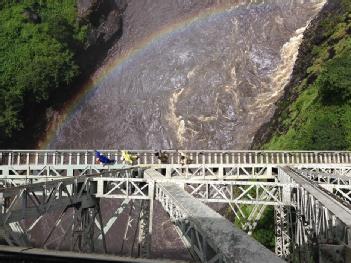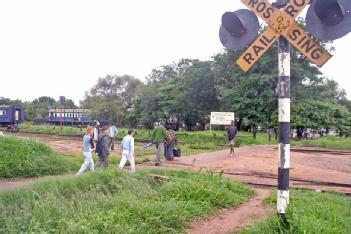
 |
Victoria Falls Bridge |
Livingstone & Victoria Falls, Zambia (& Zimbabwe) |
|
| Address |
|
| Floor area | unfortunately not known yet |
Museum typ
Exhibition
Bridges and Tunnels
- Historic Engineering Landmarks
|
Opening times
|
|
|
Status from 11/2016
|
Free entry. |
| Contact | Unknown contact data for this museum - please help via contact form. |
| Homepage | |
Our page for Victoria Falls Bridge in Livingstone & Victoria Falls, Zambia, is not yet administrated by a Radiomuseum.org member. Please write to us about your experience with this museum, for corrections of our data or sending photos by using the Contact Form to the Museum Finder.
| Location / Directions |
The Victoria Falls Bridge crosses the Zambezi River just below the Victoria Falls and is built over the Second Gorge of the falls. As the river is the border between Zimbabwe and Zambia, the bridge links the two countries and has border posts on the approaches to both ends, at the towns of Victoria Falls, Zimbabwe and Livingstone, Zambia. |
| Description | From Wikipedia, the free encyclopedia:HistoryThe bridge was the brainchild of Cecil Rhodes, part of his grand and unfulfilled Cape to Cairo railway scheme, even though he never visited the falls and died before construction of the bridge began. Rhodes is recorded as instructing the engineers to "build the bridge across the Zambezi where the trains, as they pass, will catch the spray of the Falls". It was designed by George Andrew Hobson of consultants Sir Douglas Fox and Partners, not as is often stated, Sir Ralph Freeman, who contributed to the design of the Sydney Harbour Bridge. At the time of the design of the Victoria Falls Bridge, Freeman was an assistant in the firm who, in those pre-computer days, was calculating stresses.The bridge was constructed in England by the Cleveland Bridge & Engineering Company, before being shipped to the Mozambique port of Beira and then transported on the newly constructed railway to the Victoria Falls. It took just 14 months to construct and was completed in 1905. The bridge was officially opened by Professor George Darwin, son of Charles Darwin and President of the British Association (now the British Science Association) on 12 September 1905. The American Society of Civil Engineers lists the bridge as a Historic Civil Engineering Landmark. Constructed from steel, the bridge is 198 metres (650 ft) long, with a main arch spanning 156.50 metres (513.5 ft), at a height of 128 metres (420 ft) above the lower water mark of the river in the gorge below. It carries a road, railway and footway. The bridge is the only rail link between Zambia and Zimbabwe and one of only three road links between the two countries. To push on with construction of the railway north as fast as possible, Cecil Rhodes insisted that the Livingstone to Kalomo line be laid before the bridge was finished. Then a locomotive was conveyed in pieces across the gorge by the temporary electric cableway used for the transportation of the bridge materials and nicknamed the 'Blondin' by the construction engineers. The locomotive was re-assembled and entered service months before the bridge was complete. For more than 50 years the bridge was crossed regularly by passenger trains as part of the principal route between the then Northern Rhodesia, southern Africa and Europe. Freight trains carried mainly copper ore (later, copper ingots) and timber out of Zambia, and coal into the country. The age of the bridge and maintenance problems have led to traffic restrictions at times. Trains cross at less than walking pace and trucks were limited to 30 t, necessitating heavier trucks making a long diversion via the Kazungula Ferry or Chirundu Bridge. The limit was raised after repairs in 2006, but proposals for more fundamental rehabilitation or construction of a new bridge have been aired. During the Rhodesian UDI crisis and Bush War the bridge was frequently closed (and regular passenger services have not resumed successfully). In 1975, the bridge was the site of unsuccessful peace talks when the parties met in a train carriage poised above the gorge for nine and a half hours. In 1980 freight and road services resumed and have continued without interruption except for maintenance. Today one of the Victoria Falls Bridge's main attraction are historical guided tours focusing on the construction of the bridge and include a walking tour under the main deck. On the Zambian side there is a small museum about the bridge which is free to enter and contains a cafe selling refreshments. Also located on the bridge is the Shearwater 111 metres (364 ft) bungee jump including a bungee swing and zip-line. Concerns about safety of the attraction were raised in late 2011 after the bungee's cord snapped and a young Australian woman fell 24 metres (79 ft) into the fast flowing river. |
Radiomuseum.org presents here one of the many museum pages. We try to bring data for your direct information about all that is relevant. In the list (link above right) you find the complete listing of museums related to "Radio & Co." we have information of. Please help us to be complete and up to date by using the contact form above.
[dsp_museum_detail.cfm]
| Data Compliance | More Information |
